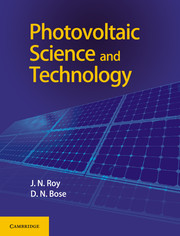Book contents
- Frontmatter
- Dedcation
- Contents
- Figures
- Tables
- Preface
- Acknowledgments
- 1 Introduction to Solar Energy and Solar Photovoltaics
- 2 Crystalline Silicon Cells
- 3 Thin Film Solar Cells
- 4 III-V Compound, Concentrator and Photoelectrochemical Cells
- 5 Organic and Polymer Solar Cells
- 6 Manufacture of c-Si and III-V-based High Efficiency Solar PV Cells
- 7 Manufacture of Solar PV Modules
- 8 Characterization, Testing and Reliability of Solar PV Module
- 9 Overview of Solar PV System Technology and Design
- 10 Design and Implementation of Off-Grid and On-Grid SPV Systems
- Index
- References
5 - Organic and Polymer Solar Cells
Published online by Cambridge University Press: 05 July 2018
- Frontmatter
- Dedcation
- Contents
- Figures
- Tables
- Preface
- Acknowledgments
- 1 Introduction to Solar Energy and Solar Photovoltaics
- 2 Crystalline Silicon Cells
- 3 Thin Film Solar Cells
- 4 III-V Compound, Concentrator and Photoelectrochemical Cells
- 5 Organic and Polymer Solar Cells
- 6 Manufacture of c-Si and III-V-based High Efficiency Solar PV Cells
- 7 Manufacture of Solar PV Modules
- 8 Characterization, Testing and Reliability of Solar PV Module
- 9 Overview of Solar PV System Technology and Design
- 10 Design and Implementation of Off-Grid and On-Grid SPV Systems
- Index
- References
Summary
INTRODUCTION
There has been rising interest followed by extensive research on organic and polymer solar cells in the last three decades. Organic semiconductors have made great strides since conductivity [1] and electroluminescence [2] in Anthracene were studied in the 1960s by Kallmann and his group. Electronic processes in organic materials have been thoroughly discussed by Pope and Swinberg [3]. Rapid progress in the field of organic materials is exemplified by the commercial success of Organic Light Emitting Diodes (OLEDS) in mobile phones and other applications. This has been possible through the tailor-making of the properties of organic semiconductors to emit light across the visible spectrum from blue to red [4]. Recently Heliatek [5], a German firm, has achieved a record conversion efficiency of 13.2% for an Organic Photovoltaic (OPV) Multi-junction (MJ) cell using small molecules. The cell has three absorber layers for absorbing light from the near infrared, red and green wavelengths, covering the major part of the solar spectrum from 450 nm to 950 nm. Stability of the small molecules is projected for 25 years. This achievement has provided great impetus to commercial development. Thus, there is, in principle, no reason why organic solar cells with their inherent advantages, discussed below, should not usher in the third generation of solar cells [6, 7].
At the outset it is necessary to distinguish between the types of organic and polymer materials for PV applications.
Organic semiconductors can be classified into two broad types [8]:
(a) Small molecules with molecular weight (MW) < 1000; usually deposited by physical vapour deposition
(b) Polymeric films[9] with molecular weight (MW) > 10,000; deposited by casting from solution, spin coating, doctor blading screen, or inkjet printing. Though thin films are reasonably easy to form, their molecular weight and purity are hard to control.
ENERGY LEVELS
Organic solids and polymers are generally considered to be insulators. However, both, the small molecules and polymers (Figure 5.1) used as light-absorbing materials have large conjugated systems in which carbon atoms covalently bond with alternating single and double bonds. These electrons in orbitals delocalize and form a delocalized bonding orbital with a anti-bonding orbital. The delocalized orbital forms the Highest Occupied Molecular Orbital (HOMO) and the orbital forms the Lowest Unoccupied Molecular Orbital (LUMO).
- Type
- Chapter
- Information
- Photovoltaic Science and Technology , pp. 134 - 157Publisher: Cambridge University PressPrint publication year: 2017



